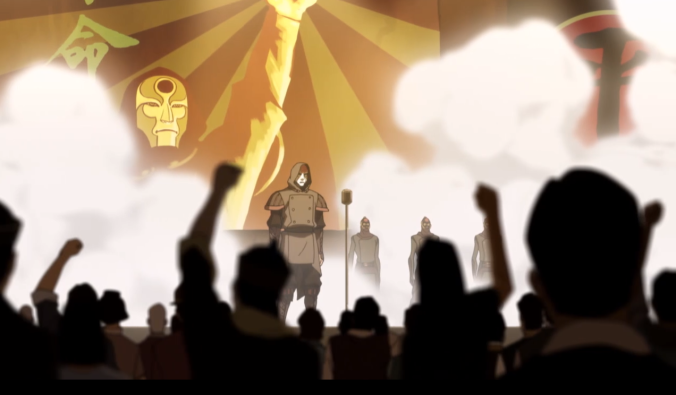Today we’re continuing to look at The Legend of Korra. Previous posts in this series have explored what makes the character and setting so strong. Today we’ll delve into the show’s plot. Specifically, we’ll look at the villains that created high stakes situations for Korra and her allies.
High Stakes
If nothing’s at stake for your characters, your audience won’t care. In his legendary screenwriting book Story, Robert McKee explains that
The measure of the value of a character’s desire is in direct proportion to the risk he’s willing to to take to achieve it; the greater the value, the greater the risk.
In other words, your character will only be willing to risk a lot if he/she wants something very badly.
There are many different ways to create high-stakes situations. The stakes could be personal (e.g. the character wants to get the girl or redeem himself). The stakes could be national (e.g. the character wants to defend her people or win the war). The stakes could be global (e.g. the character wants to save the world).
In the action/adventure genre, the central character plays the role of a hero. Just like many other heroes, Korra’s goal is global: to save the world. But it’s not that simple. Not every hero is the same. Some heroes want glory. Some heroes want revenge. Some heroes want to impress a love interest. What is Korra’s ultimate goal? Korra bears a great weight of responsibility. She is the avatar, a unique person in her world who is tasked with maintaining peace and balance. So, Korra is fulfilling a duty out of a sense of honor.
It’s incredibly difficult to write world-threatening stakes season after season without the show becoming repetitive. In The Last Airbender, Aang fought one enemy over the course of three seasons. In Korra, however, a new enemy is introduced every season.

The Equalists rally
In season 1, Amon threatens to wipe away bending from the face of the planet. This was a terrific high-stakes scenario for the show’s opening season. The creators knew that most of the audience would be familiar with The Last Airbender, so they didn’t want to repeat another war scenario. Instead, they created a subversive revolutionary group that put the heart of the Avatar world in jeopardy. They knew that their audience, and the characters, would care deeply about these stakes. But, importantly, it has quite a different flavor from Aang’s journey. Korra’s not exactly stopping an evil empire from conquering the world. It’s a new angle.
In season 2, the creators again took a brand new angle. This time, not just the physical world was at stake, but also its connection to the spirit world. The risk was very high on many accounts: If Korra didn’t stop Unalaq, a dark avatar would be born, her own connection to her past lives would be severed, and Unalaq would bring chaos upon Republic City.
Season 3 introduced us to a new type of enemy, a band of super-bending criminals. The season was intriguing because the writers kept us guessing what Zaheer’s motives were. As it turned out, they were seeking to depose all the world’s leaders. This took the primary villain type we saw in The Last Airbender (the fire lord who wanted to expand his empire) and turned that setup on its head. Instead of an all-powerful megalomaniac, Zaheer was an anarchist who wanted destroy those who were in power.
But what really made Season 3 stand out was that Zaheer was targeting Korra specifically. In season 3, shit got real because the stakes became personal.
I’ve already talked at length about why this high-stakes situation made for good character development, so I won’t get into it again.
What I’m pointing out here is that the show’s creators were able to find an interesting, unique, and new high-stakes situation for every season of the show. In order to do this, they had to ask questions like:
- What does the audience care about?
- What does Korra care about most deeply?
- How can we expand our world by introducing a villain from a new angle?
That’s how they found a fresh plot, and a new story to tell, every season.
In Book 4, the creators went back to their typical arch-villain archetype. Kuvira, like Fire Lord Ozai, was bent on conquering land for her empire. I admit, this did feel a little rehashed, but it wasn’t too bad. In the end, I believe the creators got away with it because we had seen so many different villain types over the previous 3 seasons, and especially because Zaheer was such a different type of villain and he was instrumental in taking down Kuvira. Korra’s journey against Kuvira took a very different shape from Aang’s journey against Ozai, which also helped make their plots feel distinct.
My next post will be the final one in the Legend of Korra blog series. I’ll be discussing texture and depth.

